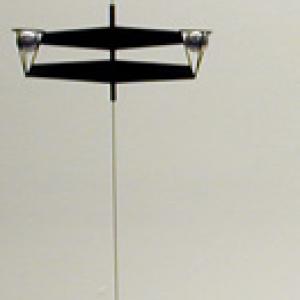College of Liberal Arts & Sciences
3A10.30 - Torsion Pendulum
Video Credit: Jonathan M. Sullivan-Wood.
Stretch the pendulum so that the wire is very tight. The different mass balls may be used to vary the pendulum period.
The old style torsion pendulum is originally a wall mount type apparatus. Copper, Brass, and Steel Rods of different diameters and with a nominal length of 1 meter are used with this apparatus. The rods are stored in the "Mechanics" section. Note that there is a ring that can also be used with the pendulum that will effectively double the mass.
- Andreas Kaps, Tobias Splith, Frank Stallmach, "Shear Modulus Determination Using the Smartphone in a Torsion Pendulum", TPT, Vol. 59, #4, April 2021, p. 268.
- I. Salinas, M. H. Gimenez, J. A. Monsoriu, and J. A. Sans, "Demonstration of the Parallel Axis Theorem Through a Smartphone", TPT, Vol. 57, #5, May 2019, p. 330.
- Tribhuvan N. Soorya, "A Modification to Maxwell's Needle Apparatus", TPT, Vol. 53, #5, May 2015, p. 282.
- "Correction to 'Effective Torsion and Spring Constants in a Hybrid Translational-Rotational Oscillator' Phys. Teach. 49, 106–109 (Feb. 2011)", TPT, Vol. 49, #7, Oct. 2011, p. 405.
- Zein Nakhoda and Ken Taylor, "Effective Torsion and Spring Constants in a Hybrid Translational-Rotational Oscillator", TPT, Vol. 49, #2, Feb. 2011, p. 106.
- Thomas B. Greenslade Jr., "Apparatus Named After Our Academic Ancestors-I", TPT, Vol. 48, #9, Dec. 2010, p. 604.
- James O'Connell, "Magnetic Torsion Pendulum", TPT, Vol. 38, #6, Sept. 2000, p. 377.
- Hilton Abbott, "Torsion Resonance Demonstrator", TPT, Vol. 21, #5, May 1983, p. 333.
- Richard E. Berg and Todd S. Marshall, "Wilberforce Pendulum Oscillations and Normal Modes", AJP, Vol. Vol. 59, #1, Jan. 1991, p. 32.
- H. M. Simpson and B. E. Fortner, "The Dynamic Shear Modulus and Internal Friction of a Fiber Vibrating in the Torsional Mode", AJP, Vol. 55, #1, Jan. 1987, p. 44.
- Philip F. Schewe, "Newton's Second Law of Motion", Physics Today, Vol. 60, #6, June 2007, p. 28.
- "M-904: Pendula - Torsion & Physical", DICK and RAE Demo Notebook.
- Freier and Anderson, "Mz-1, 2", A Demonstration Handbook For Physics.
- Richard Manliffe Sutton, "M-167", Demonstration Experiments in Physics.
- George M. Hopkins, "Cycloid Curve", Experimental Science, p. 52.
- R. W. Pohl, "4. Moments of Inertia: Torsional Vibrations", Physical Principles of Mechanics and Acoustics, p. 102.
- Colson, Lapp, and Elridge, Physics Laboratory Manual, University of Iowa, 1936, p. 32
Disclaimer: These demonstrations are provided only for illustrative use by persons affiliated with The University of Iowa and only under the direction of a trained instructor or physicist. The University of Iowa is not responsible for demonstrations performed by those using their own equipment or who choose to use this reference material for their own purpose. The demonstrations included here are within the public domain and can be found in materials contained in libraries, bookstores, and through electronic sources. Performing all or any portion of any of these demonstrations, with or without revisions not depicted here entails inherent risks. These risks include, without limitation, bodily injury (and possibly death), including risks to health that may be temporary or permanent and that may exacerbate a pre-existing medical condition; and property loss or damage. Anyone performing any part of these demonstrations, even with revisions, knowingly and voluntarily assumes all risks associated with them.
